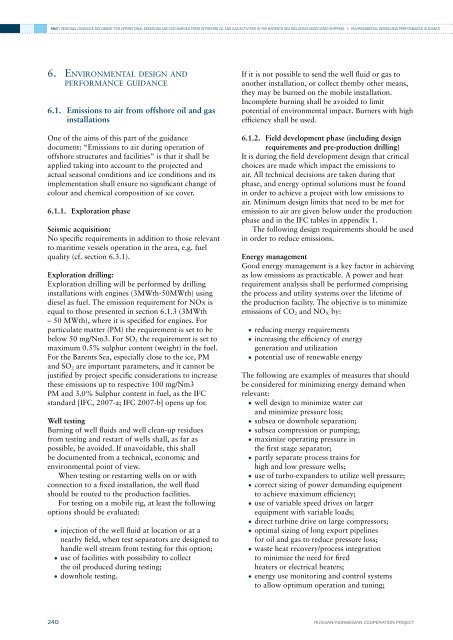phase 4 report - DNV
phase 4 report - DNV
phase 4 report - DNV
Create successful ePaper yourself
Turn your PDF publications into a flip-book with our unique Google optimized e-Paper software.
RN07: REGIONAL GUIDANCE DOCUMENT FOR OPERATIONAL EMISSIONS AND DISCHARGES FROM OFFSHORE OIL AND GAS ACTIVITIES IN THE BARENTS SEA INCLUDING ASSOCIATED SHIPPING // Environmental design and performance guidance6. Environmental design andperformance guidance6.1. Emissions to air from offshore oil and gasinstallationsOne of the aims of this part of the guidancedocument: “Emissions to air during operation ofoffshore structures and facilities” is that it shall beapplied taking into account to the projected andactual seasonal conditions and ice conditions and itsimplementation shall ensure no significant change ofcolour and chemical composition of ice cover.6.1.1. Exploration <strong>phase</strong>Seismic acquisition:No specific requirements in addition to those relevantto maritime vessels operation in the area, e.g. fuelquality (cf. section 6.3.1).Exploration drilling:Exploration drilling will be performed by drillinginstallations with engines (3MWth-50MWth) usingdiesel as fuel. The emission requirement for NOx isequal to those presented in section 6.1.3 (3MWth– 50 MWth), where it is specified for engines. Forparticulate matter (PM) the requirement is set to bebelow 50 mg/Nm3. For SO 2 the requirement is set tomaximum 0.5% sulphur content (weight) in the fuel.For the Barents Sea, especially close to the ice, PMand SO 2 are important parameters, and it cannot bejustified by project specific considerations to increasethese emissions up to respective 100 mg/Nm3PM and 3.0% Sulphur content in fuel, as the IFCstandard [IFC, 2007-a; IFC 2007-b] opens up for.Well testingBurning of well fluids and well clean-up residuesfrom testing and restart of wells shall, as far aspossible, be avoided. If unavoidable, this shallbe documented from a technical, economic andenvironmental point of view.When testing or restarting wells on or withconnection to a fixed installation, the well fluidshould be routed to the production facilities.For testing on a mobile rig, at least the followingoptions should be evaluated:• injection of the well fluid at location or at anearby field, when test separators are designed tohandle well stream from testing for this option;• use of facilities with possibility to collectthe oil produced during testing;• downhole testing.If it is not possible to send the well fluid or gas toanother installation, or collect themby other means,they may be burned on the mobile installation.Incomplete burning shall be avoided to limitpotential of environmental impact. Burners with highefficiency shall be used.6.1.2. Field development <strong>phase</strong> (including designrequirements and pre-production drilling)It is during the field development design that criticalchoices are made which impact the emissions toair. All technical decisions are taken during that<strong>phase</strong>, and energy optimal solutions must be foundin order to achieve a project with low emissions toair. Minimum design limits that need to be met foremission to air are given below under the production<strong>phase</strong> and in the IFC tables in appendix 1.The following design requirements should be usedin order to reduce emissions.Energy managementGood energy management is a key factor in achievingas low emissions as practicable. A power and heatrequirement analysis shall be performed comprisingthe process and utility systems over the lifetime ofthe production facility. The objective is to minimizeemissions of CO 2 and NO X by:• reducing energy requirements• increasing the efficiency of energygeneration and utilization• potential use of renewable energyThe following are examples of measures that shouldbe considered for minimizing energy demand whenrelevant:• well design to minimize water cutand minimize pressure loss;• subsea or downhole separation;• subsea compression or pumping;• maximize operating pressure inthe first stage separator;• partly separate process trains forhigh and low pressure wells;• use of turbo-expanders to utilize well pressure;• correct sizing of power demanding equipmentto achieve maximum efficiency;• use of variable speed drives on largerequipment with variable loads;• direct turbine drive on large compressors;• optimal sizing of long export pipelinesfor oil and gas to reduce pressure loss;• waste heat recovery/process integrationto minimize the need for firedheaters or electrical heaters;• energy use monitoring and control systemsto allow optimum operation and tuning;240RUSSIAN–NORWEGIAN COOPERATION PROJECT






![Risk Based Pipeline Integrity Management [Compatibility Mode] - DNV](https://img.yumpu.com/50424229/1/190x146/risk-based-pipeline-integrity-management-compatibility-mode-dnv.jpg?quality=85)









